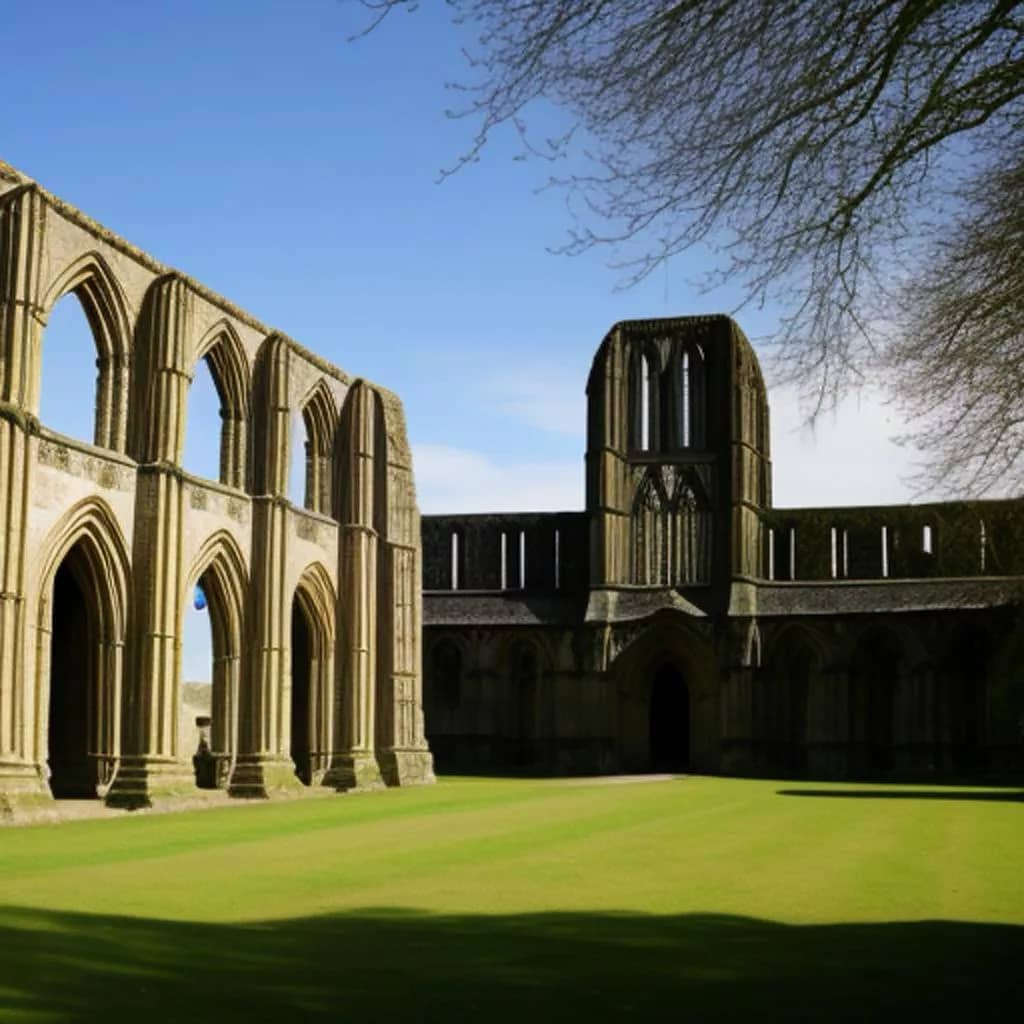
Table of Contents
Glastonbury
Glastonbury is a town located in Somerset, England, with a rich history and a variety of cultural and religious significance. Here’s an extended overview:
- Historical Background: Glastonbury has a long history dating back to ancient times. It was known to the Romans as “The Isle of Avalon,” reflecting its low-lying marshland geography in the Somerset Levels. The town is situated on a prominent hill, which has made it a site of significance throughout history.
- Arthurian Legend: Glastonbury is perhaps most famous for its association with Arthurian legend. According to medieval lore, Glastonbury is the final resting place of King Arthur and his wife, Queen Guinevere. The legendary burial site, known as Glastonbury Tor, is a prominent feature of the town’s landscape. The connection between Glastonbury and Arthurian legend has contributed to the town’s mystique and appeal.
- Christian Tradition: Glastonbury Abbey, located in the heart of the town, is one of the most historically significant Christian sites in England. According to legend, Joseph of Arimathea founded a church or chapel at Glastonbury, which later evolved into Glastonbury Abbey. The abbey became a center of Christian pilgrimage and religious devotion throughout the Middle Ages, attracting pilgrims from across Europe.
- The Holy Thorn: As mentioned earlier, Glastonbury is also associated with the legend of the Holy Thorn, believed to have grown from the staff planted by Joseph of Arimathea. The Glastonbury Thorn has become an iconic symbol of the town and a focal point of local tradition, particularly during the Christmas season when it is said to bloom.
- Spiritual Center: Glastonbury has long been regarded as a place of spiritual significance and alternative spirituality. It attracts visitors from around the world who are drawn to its mystical reputation, ancient sites, and New Age culture. The town is home to a vibrant community of spiritual seekers, artists, healers, and mystics, contributing to its eclectic atmosphere.
- Cultural Influence: Glastonbury’s cultural influence extends beyond its religious and spiritual heritage. It is famous for hosting the Glastonbury Festival, one of the largest and most iconic music festivals in the world. The festival, held annually on a nearby farm, attracts thousands of music lovers and performers, further cementing Glastonbury’s reputation as a cultural hub.
Overall, Glastonbury is a town steeped in history, legend, and spirituality, with a diverse range of attractions and influences that continue to captivate visitors from near and far.
History of Glastonbury Abbey
The history of Glastonbury Abbey is rich and storied, dating back over a thousand years. Here’s an overview:
- Early Origins: According to tradition and legend, Glastonbury Abbey traces its origins to the arrival of Joseph of Arimathea in Britain. It is said that Joseph founded a church or chapel on the site in the 1st century AD, making it one of the earliest Christian sites in England. However, historical evidence for this claim is lacking.
- Medieval Abbey: The earliest historical records of Glastonbury Abbey date to the 7th century AD when it was founded as a monastery by King Ine of Wessex. Over the following centuries, the abbey grew in importance and influence, becoming one of the wealthiest and most powerful monastic institutions in England. It played a significant role in the religious, cultural, and political life of medieval England.
- Arthurian Connections: Glastonbury Abbey became intertwined with Arthurian legend during the medieval period. According to tradition, the bodies of King Arthur and Queen Guinevere were discovered buried on the grounds of the abbey in the 12th century. This discovery elevated Glastonbury’s status as a place of pilgrimage and added to its mystique.
- Dissolution: Like other monasteries in England, Glastonbury Abbey fell victim to King Henry VIII’s Dissolution of the Monasteries in the 16th century. In 1539, the abbey was dissolved, and its lands and assets were seized by the crown. The buildings were largely dismantled, and the site fell into ruin.
- Later History: Following the Dissolution, the abbey site passed through various hands and underwent periods of neglect and decay. In the 19th century, efforts were made to preserve and restore the remaining structures, and the site became a popular tourist attraction and place of historical interest. Today, Glastonbury Abbey is managed by a charitable trust and is open to the public.
- Archaeological Discoveries: Archaeological excavations at Glastonbury Abbey have uncovered significant remains of the medieval monastery, including the foundations of the abbey church, cloisters, and other buildings. These excavations have provided valuable insights into the layout and development of the abbey over the centuries.
- Cultural Significance: Glastonbury Abbey remains a site of cultural, historical, and spiritual significance. It attracts visitors from around the world who come to explore its ruins, learn about its history, and experience its tranquil surroundings. The abbey’s connections to Arthurian legend, Christian tradition, and alternative spirituality continue to captivate the imagination of visitors and scholars alike.
Additional questions
Some additional questions you might consider asking about Glastonbury Abbey or related topics:
- What architectural features can still be seen at Glastonbury Abbey today?
Architectural Features: Some architectural features that can still be seen at Glastonbury Abbey today include the ruins of the abbey church, cloisters, chapter house, and various other buildings. Visitors can also observe remnants of medieval stonework, arches, and decorative elements.
- How did Glastonbury Abbey influence the development of Christianity in England?
Influence on Christianity: Glastonbury Abbey played a significant role in the development of Christianity in England, serving as a prominent religious center and pilgrimage site. It attracted pilgrims from across Europe and contributed to the spread of Christian faith and culture in the region.
- Are there any famous historical figures associated with Glastonbury Abbey besides Joseph of Arimathea?
Famous Historical Figures: Besides Joseph of Arimathea, Glastonbury Abbey is associated with several other historical figures, including King Ine of Wessex, who founded the monastery in the 7th century, and St. Dunstan, an influential medieval abbot and bishop.
- What role did Glastonbury Abbey play in the local economy and community during the Middle Ages?
Economic and Community Role: During the Middle Ages, Glastonbury Abbey was a major landowner and economic powerhouse, with extensive land holdings and agricultural estates. It also played a central role in the local community, providing employment, education, and charitable services.
- Are there any notable artifacts or relics associated with Glastonbury Abbey that have been preserved?
Notable Artifacts: While many artifacts and relics associated with Glastonbury Abbey were lost or destroyed during the Dissolution of the Monasteries, some items have been preserved, including medieval manuscripts, artwork, and archaeological finds such as pottery and coins
- How has Glastonbury Abbey been depicted in literature, art, and popular culture throughout history?
Depictions in Literature and Art: Glastonbury Abbey has been depicted in numerous works of literature, art, and popular culture, often romanticized for its associations with Arthurian legend, mysticism, and spirituality. It has been the subject of poems, paintings, novels, and films.
- What are some of the most significant archaeological discoveries made at Glastonbury Abbey?
Archaeological Discoveries: Archaeological excavations at Glastonbury Abbey have uncovered significant remains, including the foundations of buildings, burial sites, and artifacts dating back to the medieval period. These discoveries have provided valuable insights into the abbey’s history and development.
- How has the perception and significance of Glastonbury Abbey changed over time, particularly since the Dissolution of the Monasteries?
Changing Perception and Significance: Since the Dissolution of the Monasteries, the perception and significance of Glastonbury Abbey have evolved. From a once-thriving religious institution, it has become a symbol of England’s medieval heritage and a popular tourist destination known for its historical and spiritual associations.
- Are there any ongoing research projects or studies focused on Glastonbury Abbey and its history?
Ongoing Research Projects: There are ongoing research projects focused on Glastonbury Abbey, including archaeological studies, historical investigations, and conservation efforts aimed at preserving the site’s heritage for future generations.
- How does Glastonbury Abbey fit into the broader context of religious pilgrimage sites in Britain and Europe?
Pilgrimage Site: Glastonbury Abbey is part of a broader tradition of religious pilgrimage sites in Britain and Europe, attracting visitors seeking spiritual renewal, historical insight, and connection to sacred places. It continues to draw pilgrims from diverse religious backgrounds and cultural traditions.
Thank you for reading, shares and comments 👍
Sources openai Language models, aitrot, picsart and mib
Embark on a journey into the realm of affiliate marketing and craft your own website within a vibrant, supportive community. Join me in this adventure, where you can begin as a free starter and stay as long as you desire. Enjoy complimentary hosting and foundational teachings to set you on your path. For those with advanced skills, opportunities to elevate your expertise await. Take a moment to explore and witness the magic for yourself!




